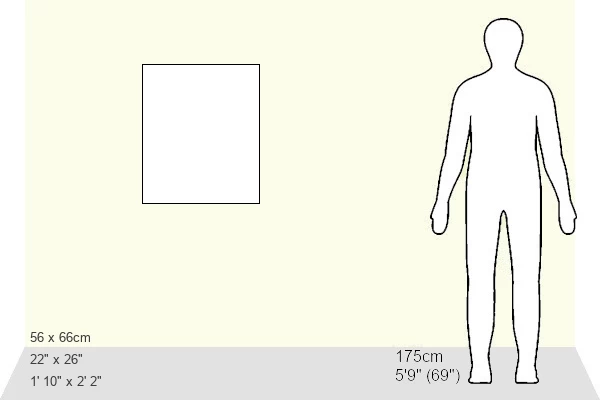Fine Art Print : Gram staining procedure, artwork
![]()

Fine Art Prints from Science Photo Library
Gram staining procedure, artwork
Gram staining procedure, artwork. Gram staining is used to differentiate between two groups of bacteria. Gram-positive bacteria are stained dark blue by the process, whereas Gram negative are unaffected. From top left to bottom right: 1) A sample of bacteria is smeared onto a glass slide. 2) The smear is dried slowly and heat-fixed to kill the bacteria. 3) The slide is flooded with gentian violet and left for 1 minute. 4) The gentian violet is washed off. 5) An iodine solution is added to aid penetration and retention of the stain. 6) After 30 seconds the slide is rinsed with ethanol, which washes the iodine out of some of the bacteria. 7) A red counter-stain (fuschin or eosin) is added to stain the Gram-negative bacteria. 8) The counter-stain is left for 30-60 seconds and then rinsed. 9) A drop of immersion oil is added to the slide, which is now ready to place under a microscope
Science Photo Library features Science and Medical images including photos and illustrations
Media ID 6324057
© PETER GARDINER/SCIENCE PHOTO LIBRARY
Apparatus Bacteria Bacterial Bacteriology Bacterium Diagrams Illustrated Method Micro Organism Micro Organisms Procedure Process Step Steps Technique Bio Chemistry Biochemical Empirical Laboratory Micro Biology Microbiological
20"x16" (+3" Border) Fine Art Print
Discover the intricacies of microbiology with our Fine Art Prints from Media Storehouse, featuring the captivating Gram staining procedure artwork by Science Photo Library. This exquisite print showcases the Gram staining process, a fundamental technique in bacteriology used to distinguish between Gram-positive and Gram-negative bacteria. The dark blue hue of Gram-positive bacteria against the contrasting background brings the intricacies of this essential lab procedure to life. Elevate your laboratory, classroom, or home decor with this striking and educational piece.
20x16 image printed on 26x22 Fine Art Rag Paper with 3" (76mm) white border. Our Fine Art Prints are printed on 300gsm 100% acid free, PH neutral paper with archival properties. This printing method is used by museums and art collections to exhibit photographs and art reproductions.
Our fine art prints are high-quality prints made using a paper called Photo Rag. This 100% cotton rag fibre paper is known for its exceptional image sharpness, rich colors, and high level of detail, making it a popular choice for professional photographers and artists. Photo rag paper is our clear recommendation for a fine art paper print. If you can afford to spend more on a higher quality paper, then Photo Rag is our clear recommendation for a fine art paper print.
Estimated Image Size (if not cropped) is 40.6cm x 50.8cm (16" x 20")
Estimated Product Size is 55.9cm x 66cm (22" x 26")
These are individually made so all sizes are approximate
Artwork printed orientated as per the preview above, with portrait (vertical) orientation to match the source image.
EDITORS COMMENTS
This artwork captures the step-by-step process of the Gram staining procedure, a fundamental technique used in bacteriology and microbiology. Against a clean white background, the illustration showcases nine distinct stages involved in differentiating between two groups of bacteria. Starting from the top left corner and progressing to the bottom right, each step is meticulously depicted. The first stage shows a sample of bacteria being smeared onto a glass slide, followed by slow drying and heat-fixing to effectively kill off any living organisms. Next, gentian violet is flooded onto the slide for one minute before being washed off. To aid penetration and retention of the stain, an iodine solution is added at stage five. After 30 seconds, ethanol rinses away some of the iodine from certain bacteria while leaving others unaffected. At this point, a red counter-stain (fuschin or eosin) is introduced to specifically target Gram-negative bacteria. The counter-stain remains on the slide for 30-60 seconds before being rinsed off. Finally, a drop of immersion oil is carefully added to prepare the slide for microscopic examination. With its precise detailing and vibrant colors against a pure white backdrop, this artwork beautifully encapsulates an essential laboratory procedure that has revolutionized our understanding of bacterial classification and identification throughout history.
MADE IN THE USA
Safe Shipping with 30 Day Money Back Guarantee
FREE PERSONALISATION*
We are proud to offer a range of customisation features including Personalised Captions, Color Filters and Picture Zoom Tools
SECURE PAYMENTS
We happily accept a wide range of payment options so you can pay for the things you need in the way that is most convenient for you
* Options may vary by product and licensing agreement. Zoomed Pictures can be adjusted in the Cart.




